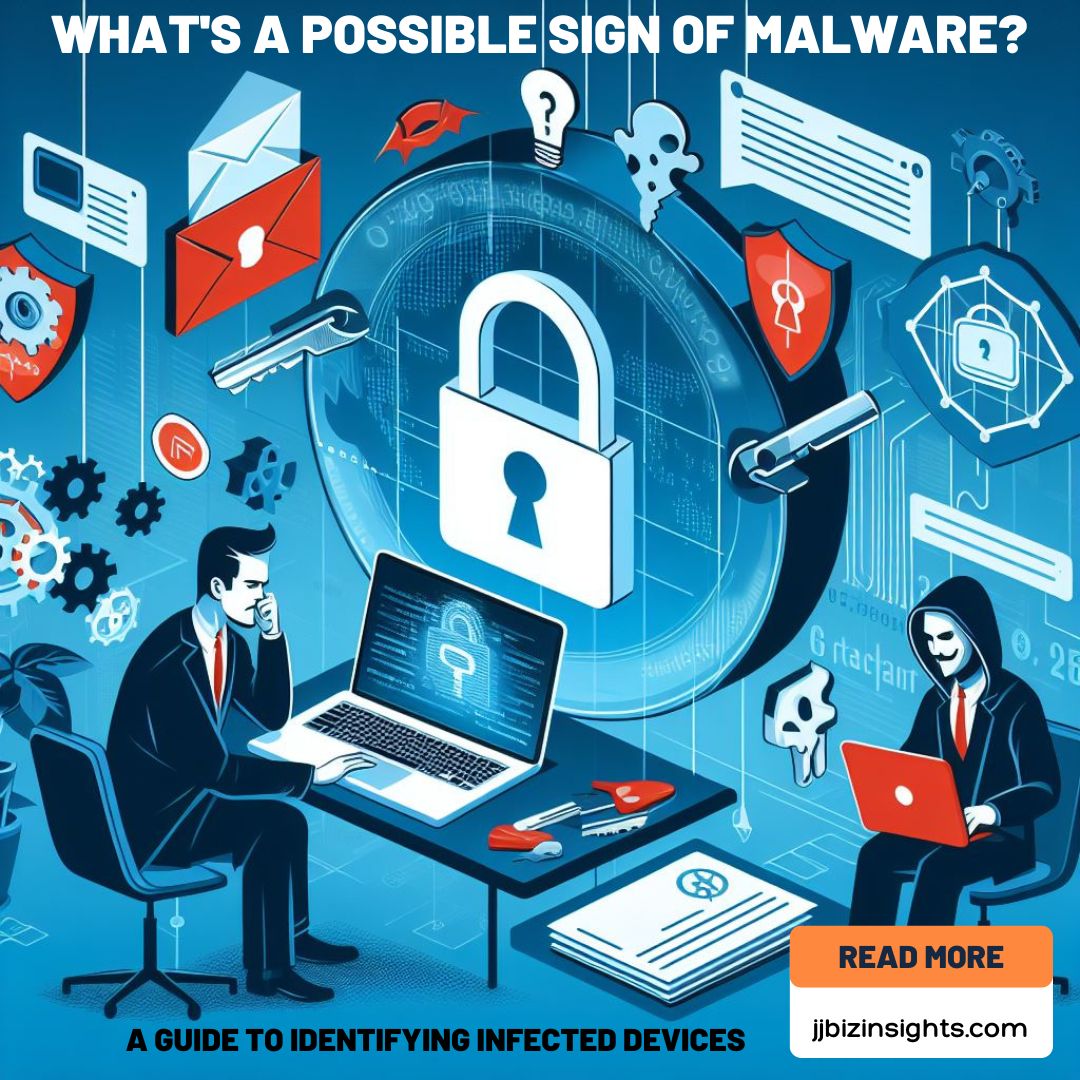
What's a Possible Sign of Malware?
What’s a Possible Sign of Malware?
What’s a Possible Sign of Malware & What is malware?
Malware, short for malicious software, refers to any software specifically designed to harm, exploit, or compromise computer systems, networks, or devices. It encompasses a wide range of harmful programs, including:
- Viruses: These attach themselves to legitimate files and spread when the infected file is executed. Viruses can corrupt data, slow down systems, or even render them unusable.
- Worms: Worms are self-replicating programs that spread across networks without user intervention. They exploit vulnerabilities to infect other devices.
- Trojan Horses: Disguised as legitimate software, trojans trick users into installing them. Once inside, they can steal sensitive information, create backdoors, or launch attacks.
- Ransomware: This encrypts files or locks users out of their systems, demanding a ransom for decryption. It can cause significant data loss and financial harm.
- Spyware: Spyware secretly monitors user activity, collecting sensitive information (like passwords, browsing habits, or keystrokes) and sending it to malicious actors.
- Adware: While less harmful, adware bombards users with unwanted advertisements. It can slow down systems and compromise privacy.
- Rootkits: Rootkits hide within the operating system, granting unauthorized access to attackers. They’re hard to detect and remove.
- Botnets: These networks of infected devices (bots) can be controlled remotely. They’re used for various purposes, including launching DDoS attacks.
Remember to keep your software updated, use reliable security tools, and practice safe online behavior to minimize the risk of malware infections. 🛡️

What’s a Possible Sign of Malware?
Is your computer running slower than usual? Are you bombarded with pop-up ads you can’t seem to escape? If so, you might have a malware infection. Malware, short for malicious software, is a broad term encompassing various programs designed to harm your device or steal your data.
Knowing what’s a possible sign of malware can help you identify an infection early on and take steps to protect yourself. Here’s a comprehensive guide to the most common signs of malware:
What’s a Possible Sign of Malware: Performance Issues
- Slowness: One of the most telltale signs of malware is a sudden decrease in your device’s performance. Malware can hog system resources, slowing down your computer’s startup time, program operation, and overall responsiveness.
- Frequent Crashes: If your computer crashes frequently or freezes unexpectedly, it could be due to malware interfering with essential system processes.
Suspicious Software Behavior:
- Pop-Up Ads: A barrage of intrusive pop-up ads, often containing flashy graphics or misleading offers, is a classic sign of adware, a type of malware that bombards you with advertisements.
- Browser Redirects: When you try to visit a legitimate website but get redirected to a suspicious or unknown one, it might be caused by malware trying to send you to phishing sites or inject unwanted content.
- Mysterious New Programs: Finding software on your device that you don’t remember installing is a red flag. Malware can sneak onto your system through hidden downloads or software bundles.
Changes to System Settings:
- Homepage Tampering: Does your web browser keep opening to a different homepage than the one you set? This could be the work of malware trying to redirect you to malicious websites.
- Disabled Security Software: If your antivirus or firewall inexplicably gets disabled, it could be malware attempting to remove its defenses.
Data Loss and Network Issues:
- Unexplained File Disappearance: Important files vanishing from your device could indicate malware activity, such as ransomware that encrypts your data and demands a ransom for decryption.
- Increased Data Usage: Malware can siphon data from your device in the background, leading to a spike in your internet data usage.
What’s a Possible Sign of Malware: Other Warning Signs
- Unusual Error Messages: Frequent error messages you haven’t encountered before could be a sign of malware interfering with your system’s normal functions.
- Suspicious Social Media Activity: If your social media accounts start posting messages you didn’t create, it’s possible malware has gained access and is using them for malicious purposes.
What’s a Possible Sign of Malware & What to Do If You Suspect Malware
If you notice any of these signs, it’s crucial to take immediate action. Here are some steps to follow:
- Run a Malware Scan: Use your antivirus or anti-malware software to scan your device for malicious programs.
- Update Your Software: Ensure your operating system, antivirus software, and other programs are updated with the latest security patches.
- Consider a Professional Scan: If the problem persists, consider seeking help from a computer technician or security professional.
What’s a Possible Sign of Malware: Prevention is Key

By staying vigilant and practicing safe computing habits, you can significantly reduce your risk of malware infection. Here are some preventive measures:
- Download Software Only from Reputable Sources: Avoid downloading software from untrusted websites or peer-to-peer networks.
- Beware of Phishing Attacks: Don’t click on suspicious links or attachments in emails, even if they appear to be from legitimate sources.
- Keep Your Software Updated: Regularly update your operating system, antivirus software, and web browser to benefit from the latest security fixes.
- Use Strong Passwords: Create strong and unique passwords for all your online accounts.
By understanding what’s a possible sign of malware and following these essential security practices, you can keep your devices safe from malicious software and protect your valuable data.
What’s a Possible Sign of Malware & How does malware spread?
Malware can spread through various channels, infiltrating unsuspecting devices and wreaking havoc. Here are common ways it propagates:
- Infected Programs: When you download and install software from untrustworthy sources, you risk introducing malware onto your system. Always verify the legitimacy of software before installation.
- Malicious Links: Clicking on infected links in emails, websites, or social media can lead to malware infiltration. Cybercriminals often disguise these links as harmless or enticing content.
- Email Attachments: Malware-laden email attachments pose a significant threat. Opening an attachment from an unknown sender can trigger an infection.
- Physical Media: Even physical devices like USB drives can harbor malware. If you connect an infected USB drive to your computer, the malware can transfer.
- Networks: Malware can spread across networks, infecting connected devices. Vulnerabilities in network security allow malicious code to move from one system to another.
Remember to stay vigilant, use reliable antivirus software, and exercise caution when interacting with unfamiliar content. 🛡️🔍
What’s a Possible Sign of Malware & Can a website give me a virus?
Let’s explore the possibility of getting a virus from visiting a website:
- Drive-By Downloads: Historically, drive-by download attacks required user interaction (such as clicking on a banner). However, there have been instances where drive-by downloads successfully infected browsers (including Chrome) without user interaction. For example, the CVE-2011-0611 vulnerability allowed attackers to infect the homepage of the Human Rights Watch website in the UK. The infected page contained rogue scripts that executed malicious code.
- Compromised Websites: If a website has been compromised or contains malicious code, visiting it can lead to virus infection. Even if you don’t intentionally download anything, the website might exploit vulnerabilities in your browser or operating system.
- Email Links and Images: Be cautious with email links and images. Some marketing emails use unique IDs to track active email addresses. Clicking on these links can inadvertently inform spammers that your address is active.
In summary, yes, you can get a virus just by visiting a website. To protect yourself, install up-to-date antivirus software and exercise caution when exploring unfamiliar sites. Stay vigilant! 🛡️🔍
How to Prevent Ransomware Attacks: A Comprehensive Guide





